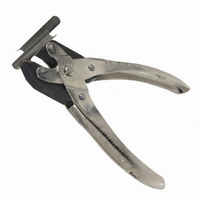ATC 2281 Astro Tool Corp, ATC 2281 Datasheet - Page 6

ATC 2281
Manufacturer Part Number
ATC 2281
Description
TOOL EXTRACTION #8 CONTACT METAL
Manufacturer
Astro Tool Corp
Datasheet
1.ATC_2426.pdf
(93 pages)
Specifications of ATC 2281
Tool Type
Extraction Tool
For Use With/related Products
Circular Connector Contacts
Lead Free Status / RoHS Status
Not applicable / Not applicable
Other names
ATC2281
VISUAL INSPECTION
each contact is inspected under a microscope to make certain the
indenture does not crack or tear the base metal, or cause excessive
distortion of the contact.
CONTROLLING CRIMP DEPTH
From the tensile curves, a known crimp depth range is established.
It is imperative, therefore, that the crimp tool settings be within the
established tolerance.
To insure full closure of the tool handles and positive bottoming, it is
necessary that tools be cycle controlled. This is accomplished by the use
of a precision ratchet device which releases the handles at the positive
bottoming position within specification tolerances. This release point
and positive bottoming are applicable to all contact sizes.
MEASURING CRIMP DEPTH (GAGING)
Too loose a crimp setting will result in wire pullout and high millivolt
drop (high resistance). Too tight a setting will nick the wire strands
causing low tensiles and wire breakage within the contact.
Positive bottoming tools can readily be gaged by selecting gage pins
dimensioned to the end limits of the known crimp range of a given
contact.
AXIAL DEFORMATION
During the crimping process considerable force is applied and material
displacement takes place, which may result in axial deformation of the
contact. The following factors contribute to axial deformation of contacts:
10. Method of measuring axial deformation - we have found that
MIL-DTL-22520 is specific in defining and evaluating the axial
deformation of contacts. This paragraph allows the following
deformation:
fIG. 3
1. Contact material and contact hardness.
2. Crimp barrel wall thickness.
3. Concentricity of conductor hole to O.D. of crimp barrel.
4. If an insulation support is included on the contact, the concentricity
5. Crimp depth - the deeper the crimp the greater the possibility of
6. Conductor characteristics - conductor hardness, number of strands,
7. The condition of the indenters - indenters which are not uniformly
8. The condition of the crimping tool - a worn crimping tool can
9. Method of contact location and support - improperly supporting or
of this support (I.D. and O.D.) with respect to the other diameters in
the contact.
contact bending.
size of wire, bunching of strands, the lay of the conductors, plating
or the use of solid conductor.
dimensioned or aligned or which have extreme variation in surface
condition can cause contact bending.
contribute to contact bending.
positioning the contact in the tool can result in contact bending.
this is one of the least understood items relating to the crimp
tool specification.
Contact size
20 & smaller
16
12
Contact Deformation
.011 TIR
.012 TIR
.012 TIR
© Copyright 2008 Astro Tool Corp. , 21615 SW Tualatin Valley Highway, Beaverton, OR 97006
The TIR allowed includes a maximum of .005 TIR assignable to the
contact during its manufacture. (TIR is an abbreviation for Total
Indicator Reading and is a measure of the total deviation from a true
center line when the item being measured is rotated through 360 °.)
COMPRESSION FORCES
Crimping compression forces are directly related to: A. Indenter
Configuration; B. The Amount of Leverage in a Crimping Tool; C. Crimp
Depth Required for Satisfactory Results; D. Contact Hardness and
Contact-Conductor Combinations.
A. Indenter Configuration
B. The Amount of Leverage in a Crimping Tool
C. Crimp Depth Required for Satisfactory Results
D. Contact Hardness and Contact-Conductor Combinations
As can be seen from this brief review of crimping, many factors
influence the effectiveness of a crimped joint. However, a good crimping
tool compensates for many of these factors by providing proper crimp
depths, resulting in termination having high tensile strength, low
millivolt drop, and minimum contact deformation. With the use of
a well-engineered tool, crimping becomes one of the most reliable
methods of wire termination.
A glossary of connector terms is available at www.astrotool.com.
MS drawings are specific as to indenter configuration of the Class I
crimping tool. It is possible to change the shape of the indenters to
reduce frontal area and thus reduce crimping forces. If the reduction
of compression forces was the only factor involved, a knife blade
edge on an indenter, or a conical tip shape would be the most
desirable configuration. But this would result in cracked contacts,
damage to plating, high wire embrittlement because of the
concentrated stress of a small crimp area, and would also result
in marginal tensile values.
Leverage or linkage systems could be devised to minimize the amount
of crimp compression forces. Archimedes’ old adage could apply here
wherein he says, “Give me a place to stand and to rest my lever on
and I can move the earth.” From a practical viewpoint, however, the
geometry of Class I tools under MIL-T-22520 are specific in tool length
and width.
Another way to reduce compression forces is to vary crimp depth.
MS drawings are specific in designating crimp depths. It is
understandable that the less the indenters indent the lower the
compression forces involved. On the other hand, if the tool does not
indent as deeply as specified, the possibility exists that sub-marginal
or marginal tensile values will result.
Contact material is definitely a factor contributing to high
compression forces. Some contacts are made of hard material; some
contacts have thick walls and some contacts are required to cover a
range of conductors, all of which could involve high crimping forces.
It is felt that an analysis of these conditions and an attempt to make
them compatible with the crimping tool could facilitate the reduction
of compression forces.
•
Tel: (503) 642-9853
•
www.astrotool.com
5










